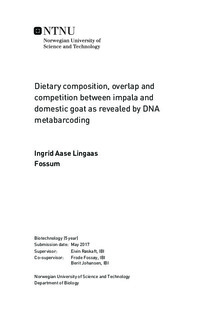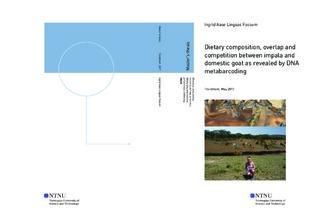| dc.description.abstract | In a world with a rapidly growing human population and limited resources, it is important to understand how we interact with wildlife to ensure their conservation. In Tanzania, the human population has more than tripled over the last 50 years. Many people live in rural areas, where they are directly dependent on the surrounding natural resources for food, water, grazing land for livestock, materials, firewood, and income. Simultaneously, Tanzania is home to Serengeti National Park, which is famous for its species diversity and for the annual large-scale migration of ungulates. With the growing human population, the number of domestic livestock also increases. Wild impala (Aepyceros melampus) outside the national park coexist with the domestic goat (Capra hircus) and could thus experience dietary competition from goats when they turn to browsing in the dry season. In this study, I investigated the dietary composition and overlap between impala and goat using DNA metabarcoding of faecal samples. I sampled impala inside Serengeti National Park, and west and east of the park, where I also sampled adjacent goats. Firstly, impala had a higher diversity of diet items, which could be an advantage for them in a potential competition with goats. Secondly, impala and goats share many of their most abundant species, especially shrubs and trees. One or more species of the Fabaceae family had the highest abundance and occurrence for both study species, and for impala, the diet was also dominated by one or more grasses of the PACMAD clade. It was also shown that the degree of dietary overlap between the species is higher than would be expected if they had used the resources independently of one another. Lastly, it was shown that habitat has a greater effect on the diet than the study species, implying that there is a great variance in habitat within the study area and that both goats and impala eat what is available in the different habitats. The dietary overlap indicates that there is potential for competition, especially in the dry season, when impala forage more on shrubs and trees, and when the human and livestock population continues to increase. However, to conclude on the degree of competition, more data is needed on the local plant abundance, and the genetic reference library should simultaneously be expanded with local plant species to know more about the diet on the plant species level. Meanwhile, management should consider the potential threat of domestic goats in the future studies on impala. | |

